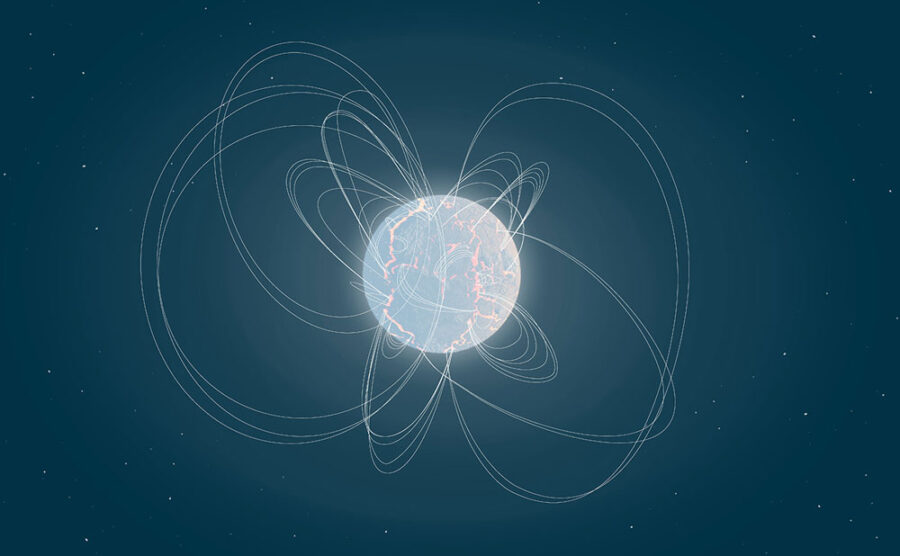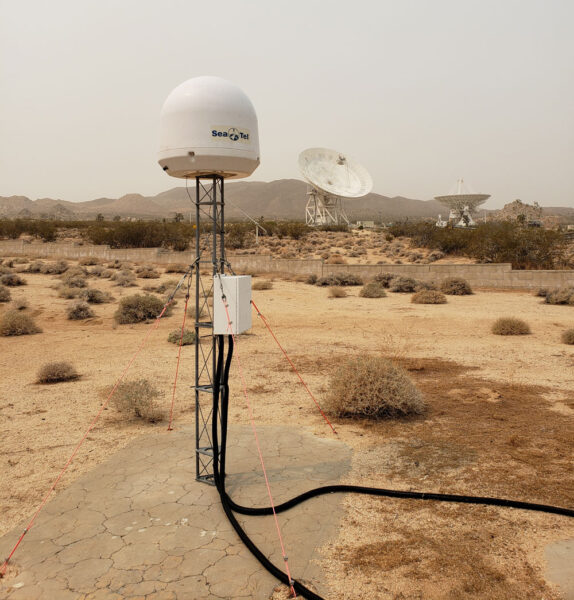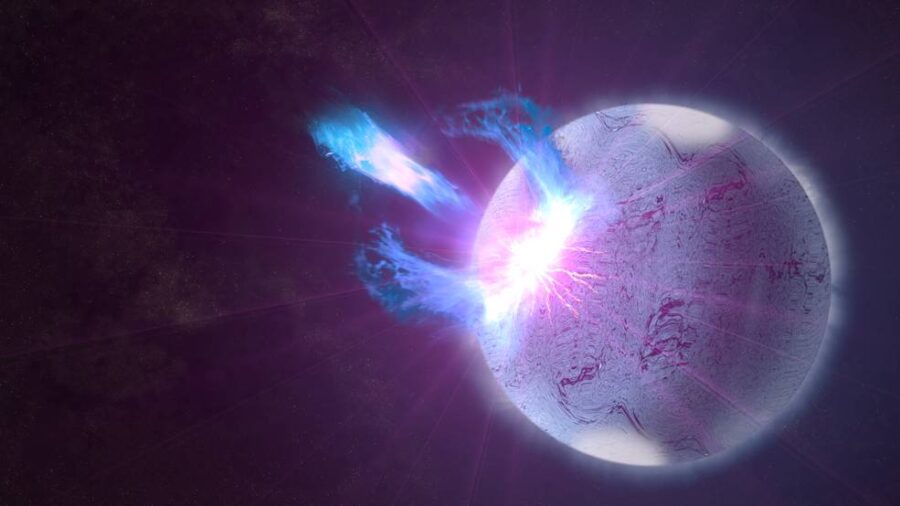In-depth analysis of a flash of radio waves coming from a Milky Way magnetar have convinced astronomers: Magnetars produce at least some fast radio bursts.
Earlier this year, we reported that a Milky Way magnetar — an ultra-magnetized neutron star — had released a powerful radio burst, accompanied by a flood of X-rays. The source looked very much like extragalactic fast radio bursts (FRBs), brief yet powerful flashes of radio waves, some of which have been spotted coming from more than a billion light-years away.

ESA
Astronomers have counted up to 118 FRBs so far (and there are hundreds more in the pipeline that still need to be verified), but until now none of them has been associated with a known source. The flashes are so brief — mere milliseconds long — that astronomers have struggled to localize them, relying mostly on the few that repeat. Whole new instruments have been constructed to find and pinpoint FRBs.
Now, in the November 4th Nature, international collaborations make it official: The radio-wave flash coming from the Milky Way magnetar was indeed an FRB, now designated FRB 200428. And it has seriously narrowed the playing field for explanations of these mysterious sources.
A Fast Radio Burst from a Neighbor
The Canadian Hydrogen Intensity Mapping Experiment (CHIME) consists of four giant half-pipe antennas in British Columbia, and while not designed to catch FRBs, it has proven to excel at it. On April 28th, CHIME spotted two powerful bursts of radio waves, each less than a millisecond long and separated by only 30 milliseconds. The whole event was over within a fraction of a second.

Andre Renard / CHIME
The telescope had caught the event in its peripheral vision (in technical terms, the source appeared in CHIME’s far-sidelobe). Nevertheless, the team calculated a precise-enough location on the sky to identify the event as coming from the active magnetar dubbed SGR 1935+2154, 30,000 light-years away.
The discovery hastened work by the team behind the Survey for Transient Astronomical Radio Emission 2 (STARE2), who had constructed their instrument specifically to search for FRBs emanating from somewhere in the Milky Way. Based on the first year of observations (and zero detections), the team had concluded that there was less than a 10% chance of actually seeing an FRB coming from something within our own galaxy, explains graduate student Christopher Bochenek (Caltech).
“When I looked at the data the first time, I froze,” he says. “I was basically paralyzed with excitement.”
While CHIME provided the source’s location, STARE2 was better able to estimate the energy flowing out of the magnetar in such a short time. “With STARE2, we were able to confirm that the energy of this burst is comparable to the energy of extragalactic FRBs,” Bochenek explains. But comparable doesn’t mean equal to — the magnetar’s radio outburst was about 30 times weaker than the weakest FRB coming from outside our galaxy. And it’s 1,000 times fainter than the typical extragalactic FRB.

NASA / JPL-Caltech
“What’s surprising is that we saw anything at all from our own galaxy given how rare FRBs are,” Bochenek says. The detection suggests a proverbial iceberg of FRBs, with most events occurring at lower energy levels, so far unseen.
A flurry of other observations followed CHIME’s announcement, as attested by the long thread of related results reported to the community in The Astronomer’s Telegram. Many of these came from observatories already following the magnetar, such as the Chinese Five-hundred-meter Aperture Spherical Telescope (FAST), the world’s largest radio dish that had started observing the magnetar earlier that month, and NASA’s Neil Gehrels Swift Observatory, a satellite monitoring X-ray and gamma-ray emissions from the magnetar.
While Swift spotted a powerful X-ray burst that accompanied the radio waves, FAST — a far-more sensitive telescope than either CHIME or STARE2 — saw nothing. The radio dish had just missed observing the magnetar during the FRB event. And while FAST did watch the magnetar in the following days as it continued to erupt with gamma rays, the team didn’t find any radio pulses emitted at the same time.
A Magnetar for Every One?
The magnetic fields around the neutron stars known as magnetars is fierce: more than 1013 Gauss, or 10 million times stronger than the strongest manmade magnet. However magnetars came by these extreme fields (it’s still unclear), their sheer strength suggests they can power some intense activity. Indeed, astronomers give magnetars credit for some of the most energetic events in the universe, including FRBs shortly after their discovery in 2007.
Nevertheless, Bing Zhang (University of Nevada) says, “Magnetars were not fully established as the main source before this.” Even earlier this year, observations of another erupting magnetar had put such tight upper limits on its radio emissions that some astronomers suspected magnetars would never be able to supply the power needed to make FRBs.
Now, the discovery narrows the playing field, suggesting that of the dozen or so ideas that have been proposed to explain FRBs, one of them — magnetars — is right at least some of the time. What’s more, because STARE2 was specifically designed to detect Milky Way FRBs and has already been observing our galaxy for more than a year, Bochenek and his colleagues were able to estimate the rate of such magnetar outbursts, which turns out to be high enough to explain all known FRBs.

NASA's Goddard Space Flight Center / S. Wiessinger
That’s not to say that other explanations are ruled out, though. The Milky Way magnetar hasn’t repeated its burst in the way that other FRBs have, Zhang notes. Such “prolific repeaters” must represent a different sort of magnetar, perhaps newborn and rapidly rotating, he suggests, if indeed they are magnetars at all.
One scenario that is mostly ruled out, though, is the idea that whatever powers FRBs is catastrophic, such as a neutron star merger or a neutron star collapsing into a black hole. “There’s no support for those scenarios yet,” says Daniele Michelli (McGill University, Canada), a member of the CHIME collaboration. “If they exist, they must be very rare. Only a small fraction of FRBs is allowed to be catastrophic.”
Further Reading:
Milky Way Magnetar Makes Fast Radio Burst (May 8, 2020)
New Mysterious Radio Flash Pinned Down; Hundreds More Being Discovered (January 17, 2020)
Hall, Shannon. "The Mystery of Fast Radio Bursts." Sky & Telescope, July 2016.
References:
Daniele Michelli et al. "A bright millisecond-duration radio burst from a Galactic magnetar." Nature, 2020 November 4
Christopher Bochenek et al. "A fast radio burst associated with a Galactic magnetar." Nature, 2020 November 4
Bing Zhang et al. "No pulsed radio emission during a bursting phase of a Galactic magnetar." Nature, 2020 November 4
Bing Zhang. "The physical mechanisms of fast radio bursts." Nature, 2020 November 4
 1
1









Comments
Michal
November 4, 2020 at 6:04 pm
An interesting story about the telescopes used is at the following link which describes them as "a California doctoral student’s set of handmade antenna's, which included actual cake pans, the other a $20 million Canadian observatory."
https://apnews.com/article/astronomers-find-cosmic-radio-source-9aa883306b24272e6fa44c501b5ade11
and Christopher Bochenek's webpage here: https://sites.astro.caltech.edu/~cbochenek/
You must be logged in to post a comment.
You must be logged in to post a comment.